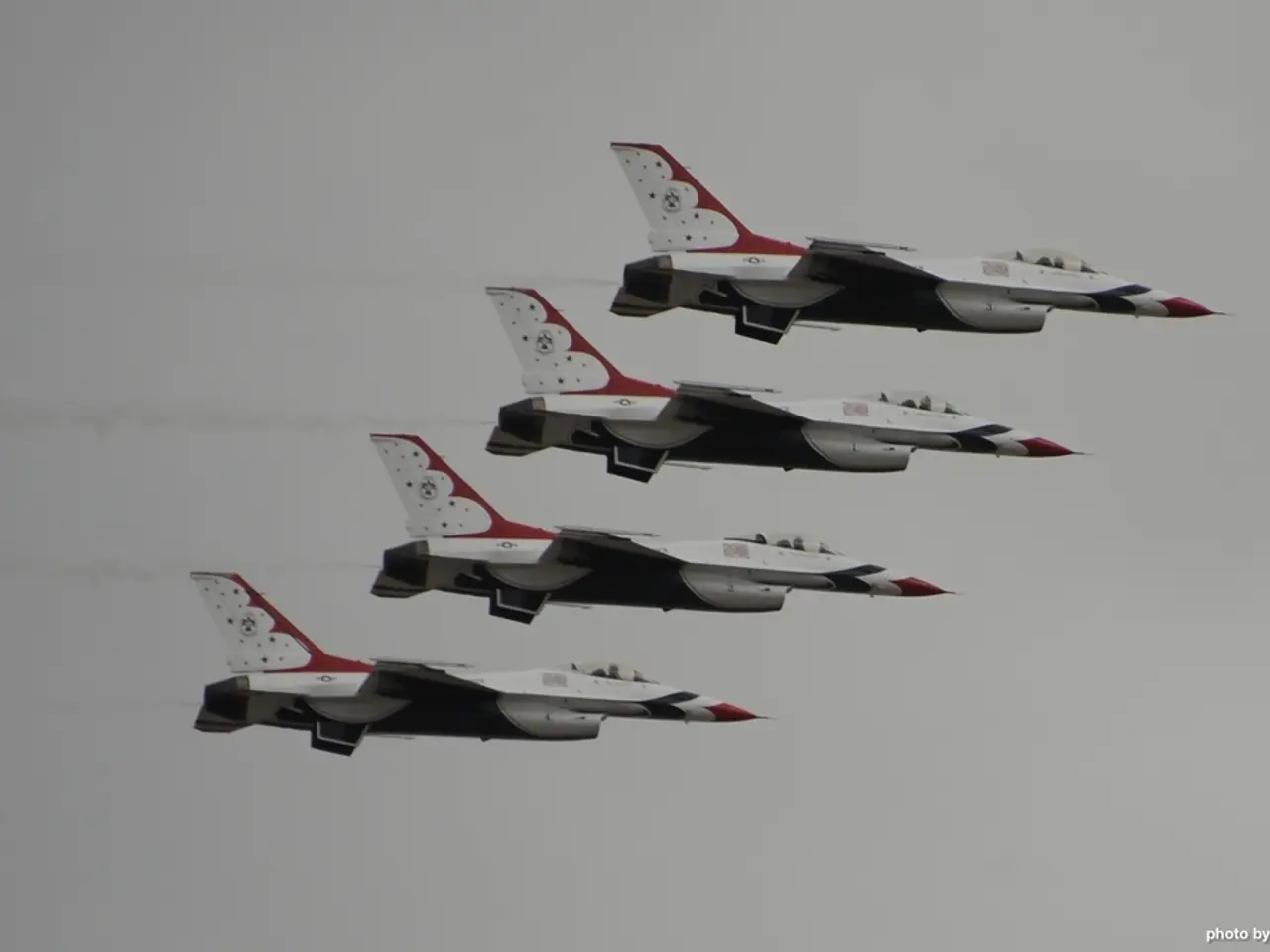E-7 plane retirements would be avoided, while the retirement of A-10 aircrafts would be prevented, under the draft authorization proposed by HASC.
The House Armed Services Committee has passed a draft of the 2026 defense policy bill, marking a significant step towards bolstering the military's resources for the fiscal year starting October 1, 2025.
The proposed budget for the Department of the Air Force, which includes both the Air Force and Space Force, is set at a total authorization of at least $221 billion. This figure represents a substantial increase over previous years, with the Air Force and Space Force requesting $211 billion through the normal budget process, reflecting a 17% increase over the previous year.
The bill includes provisions that aim to address major design issues with the KC-46 Pegasus tankers, preventing the Pentagon from bringing on more than 183 units until a corrective action plan is in place. The Air Force is also barred from retiring or shrinking the A-10 "Warthogs" below 162 planes until Oct. 1, 2027.
Lawmakers have backed multiple provisions meant to bolster the mobility and aerial refueling fleets. The air refueling aircraft floor is raised to 504 aircraft by 2027, and the F-15EX procurement for FY26 is authorized by the reconciliation bill. The bill also looks to save the Air Force's plan to buy two E-7 Wedgetail airborne target-tracking jet prototypes from cancellation.
The bill boosts funding for the new Sentinel ground-based nuclear missiles to over $3 billion. Rep. Trent Kelly (R-Miss.) supports airborne force projection with the B-21 and C-130J aircraft, and an amendment in the bill presses the Air Force for a report on the next-generation F-47 program.
The bill contains myriad other spending tweaks and oversight provisions. Notably, it authorizes $848.2 billion for the military, including at least $211.3 billion for the Air Force and Space Force. The Senate and House Armed Services Committees have both finalized their respective versions of the annual defense policy bill, and a compromise bill typically heads to the president's desk at the end of the calendar year.
The passage of this bill is crucial for maintaining a ready, lethal, and capable fighting force, as stated by Rep. Mike Rogers, committee chair. The House Armed Services Committee passed the draft of the 2026 defense policy bill on July 15, and the bill now moves forward for consideration by the full House.
[1] Source: Defense News
The draft 2026 defense policy bill passed by the House Armed Services Committee proposes a total authorization of at least $221 billion for the Department of the Air Force, which includes both the Air Force and Space Force, for the fiscal year starting October 1, 2025. This figure encompasses various efforts including aircraft procurement, research and development, and personnel.
More specifically, the total sum for the Air Force and Space Force is likely around $46 billion higher when accounting for troop pay and personnel funding not broken out separately by service in the legislation. The Air Force and Space Force requested $211 billion through the normal budget process, reflecting a 17% increase over the previous year, and secured additional funds as part of a broader tax-and-spending package to approach a $250 billion total budget request for 2026.
Thus, the proposed budget in the draft bill passed by the House committee allocates roughly $221 billion directly through the defense policy legislation, with a total closer to $250 billion when including supplemental funding sources, representing a significant increase over previous years for Air Force and Space Force needs.
An amendment in the bill presses the Air Force for a report on the next-generation F-47 program. The F-15EX procurement for FY26 is authorized by the reconciliation bill, and the air refueling aircraft floor is raised to 504 aircraft by 2027. The bill looks to save the Air Force's plan to buy two E-7 Wedgetail airborne target-tracking jet prototypes from cancellation.
The bill boosts funding for the new Sentinel ground-based nuclear missiles to over $3 billion. Rep. Trent Kelly (R-Miss.) supports airborne force projection with the B-21 and C-130J aircraft.
The inventory requirement of 271 C-130 aircraft for intra-theater airlift is maintained. Another provision stops the Air Force from retiring or shrinking the A-10 "Warthogs" below 162 planes until Oct. 1, 2027. A provision also stops the Pentagon from bringing on more than 183 KC-46 Pegasus tankers until a corrective action plan is in place for all of the plane's major design issues.
The Senate and House Armed Services Committees have both finalized their respective versions of the annual defense policy bill, and a compromise bill typically heads to the president's desk at the end of the calendar year. The House Armed Services Committee passed the draft of the 2026 defense policy bill on July 15, and the bill now moves forward for consideration by the full House.
[1] Source: Defense News
The bill authorizes $848.2 billion for the military, including at least $211.3 billion for the Air Force and Space Force. Eleven standalone amendments made it through the markup for consideration by the full House. The authorization bill allows the military to spend money provided by congressional appropriators when the next fiscal year begins.
The amendment to bar the use of federal dollars for retrofitting the Qatari Boeing 747 as an interim Air Force One failed. The bill contains myriad other spending tweaks and oversight provisions. The passage of this bill is crucial for maintaining a ready, lethal, and capable fighting force, as stated by Rep. Mike Rogers, committee chair.
[1] Source: Defense News
- The House Armed Services Committee has passed a draft of the 2026 defense policy bill, a significant step towards bolstering military resources for the fiscal year starting October 1, 2025.
- The Department of the Air Force, which comprises both the Air Force and Space Force, is set to receive a total authorization of at least $221 billion in the proposed budget.
- This budget reflects a 17% increase over the previous year, with the Air Force and Space Force requesting $211 billion through the normal budget process.
- The bill includes provisions to address problems with the KC-46 Pegasus tankers, preventing the Pentagon from bringing on more than 183 units until a corrective action plan is in place.
- The bill authorizes the Air Force to purchase the F-15EX for FY26 and raises the air refueling aircraft floor to 504 aircraft by 2027.
- Rep. Trent Kelly (R-Miss.) supports airborne force projection with the B-21 and C-130J aircraft, and the bill presses the Air Force for a report on the next-generation F-47 program.
- The bill boosts funding for the new Sentinel ground-based nuclear missiles, saving the Air Force's plan to buy two E-7 Wedgetail airborne target-tracking jet prototypes from cancellation, and maintains the inventory requirement of 271 C-130 aircraft for intra-theater airlift.




